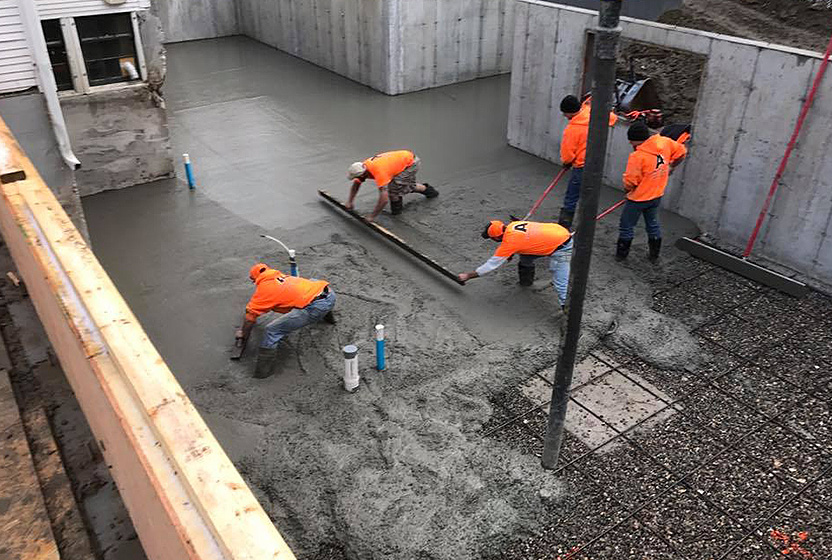Services
Monolithic slabs
Do you have a new construction project underway? This is the perfect time to start thinking about using a monolithic slab foundation to save time and cut costs!



The classic concrete foundation has three elements: footings, foundation walls, and a slab. Footings are large pieces of concrete that sink deep into the ground in order to evenly distribute the weight of the building which keeps cracks from forming and keeps the structure stable. In cold climates, footings also keep the frost out because they rest deep below the point where frost is normally able to penetrate. If footings aren’t placed sufficiently deep into the ground, water in the soil will do what water does: freeze and melt. Every time the water turns to ice it expands in volume before thawing once more and creating a space in the ground that the foundation will inevitably sink down into. You see the same thing with sidewalks that have gone through a tough winter or two—so just picture if that were to happen underneath your home!
Next, you have the foundation walls. These are made of wide pieces of concrete that sit on the footings and have contact with the rest of the structure. You’re probably seen them before if you’ve been in an unfinished basement, the exposed walls are the foundation walls. Sandwiched between the foundations walls and the footings is the foundation slab. This huge chunk of concrete is your basement floor, also called a subfloor.
Each of these elements is essential to the whole, and must be poured and allowed to cure separately. Each piece of the puzzle can require up to a week to complete. This means that building the foundation is a sizeable chunk of the construction timetable, and is also a very costly aspect of the project. Hence the genius of monolithic slabs, which encompass the footings and the foundation slab into one piece. With monolithic slabs, both pieces of the foundation around poured and cured simultaneously so you save days on the job and money at the bank!
Not only does the monolithic slab combine two steps of the foundation laying process, it also has considerably less bulk than its traditional counterpart. They are about four inches thick on average, and the footings are only about a foot long from base to the top of the floor, meaning they only need to be dug in 6 inches below the surface. You can do that with a shovel from your garage if you feel like it! The slab usually sits on a bed of gravel to increase the amount of drainage. It also is reinforced with wire mesh or rebar to make it extra sturdy and keep it from cracking. In harsh winter climates like those of Montana, it is also wise to incorporate internal heating and add a layer of insulation around the edge of the foundation to keep the frost at bay and protect the foundation from freezing and thawing in the ground.
This style of foundation isn’t right for every kind of structure in Montana, so be sure to look into local building codes for what is deemed legal and proper. Monolithic slabs can be used anywhere that regulations allow and conditions make possible, and are well-suited for exterior structures like sheds, gazebos, detached garages, car ports and even small barns. A monolithic slab foundation is the way to go if you want to save a considerable chunk of change and shorten the timeline of your construction project.
